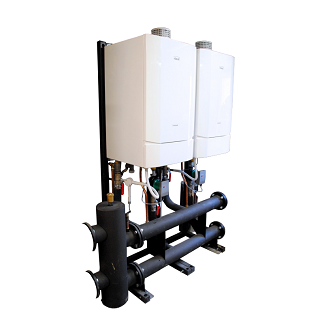By their very nature, heating systems can become contaminated with debris and dirt over the years. When installing new boilers onto an old system, the very last thing you want is for that ‘dirty’ water to circulate through your new boiler as it may impact its efficiency, lead to boiler breakdowns and reduce its working life.
How can I prevent old system water circulating through a new boiler?
System separation will prevent this. This can be achieved through using low loss headers and plate heat exchangers with filters or strainers, or air and dirt separators to assist with removal of harmful debris in the system.
What is a low loss header?
A low loss header is essentially a large chamber through which the system water flows at a low velocity. As the flow rate through the header is very slow, dirt and debris fall to the bottom, where they are removed via a drain valve. To prevent any of the debris that settles out being carried back through the boiler, low loss headers are normally mounted vertically. This also allows any air in the system flow to migrate up to a point where it can be vented. If you are using a horizontal low loss header, it’s important to employ additional dirt separation on the return to the main plant.
In systems based on ferrous metals, such as iron and steel, consider using a magnetic low loss header which combines the benefits of a low loss header with the addition of a magnet inside it, capturing the magnetite particles as well.
Are their other benefits to using a low loss header?
Low loss headers have a further benefit in that they enable the commercial boiler to operate independently to a system where the load is likely to be variable and the operating range for the system may not be ideally suited to the boiler. For the boiler, if it was installed directly to the system pipework, a variable flow rate may lead to minimum flow rates for the boiler not being maintained. By keeping both systems hydraulically separate, each side of the system can operate without disturbing the other. The boiler can provide as little or as much heat input as is required, and the system load can vary over a very wide range without affecting the boiler.
How do I specify a low loss header?
When specifying a low loss header, talk to us first to confirm that it's suitable for the type of product you're going to use it with and your expected flow rates. If the flow velocity in the body of the header isn't low enough, you won't get effective separation between the two systems.
What is a plate heat exchanger?
Moving on to plate heat exchangers, which are becoming the more popular choice, this method of separation works by transferring heat from the boiler circuit to the system circuit without the two circuits coming in direct contact; they are hydraulically separated by a pressure break with no mixing of the fluids in the different systems. The heat is transferred through a series of parallel plates with channels between them which the water can flow through independently of the other system.
Plate heat exchangers are typically offered in two types, gasketed and brazed. Gasketed plate heat exchangers comprise a series of plates fitted with elastomeric gasket which are retained in a frame whereas brazed plate heat exchangers eliminate the gasketed joints, often allowing for higher design pressures and temperatures.
Why should I use a plate heat exchanger?
The advantage of installing a plate heat exchanger onto a system is that they do more than simply protect the boilers from potentially poor quality water. The boiler circuit and secondary circuit can operate at different temperature profiles provided the plate heat exchanger is specified correctly; the two systems can operate at different pressures; or the fluid within the secondary system could be a process or food grade fluid that could not be heated directly by a boiler.
How do I specify a plate heat exchanger?
Something to take into consideration when looking to install a plate heat exchanger would be the heat transfer capacity and the temperature profiles on each side of the plate. These parameters will have a direct impact on how effectively the plate heat exchanger will function, therefore the plate will need to be accurately sized prior to installation to achieve and maintain these parameters. If in doubt, contact us for advice – we are happy to help!
At Ideal Heating Commercial we offer a comprehensive range of hydraulic separation equipment to suit all of our commercial boilers and heat pumps. To find out more about what we have on offer speak with your business development manager.


